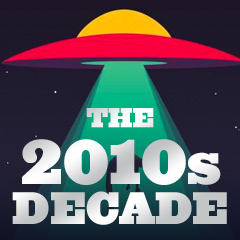|
The Hype of 3-D:
 After
the success of the record-breaking Avatar (2009) and Alice
in Wonderland (2010) in 3-D, studios embraced the ground-breaking
technology. In 2010, 21% of total box-office revenue in North America
($10.6 billion), or $2.2 billion, came from 3-D tickets sales. Four major
studios (Fox, Paramount, Disney, and Universal) spent $700 million to
equip theaters with new projectors, and started to release more 3-D pictures. After
the success of the record-breaking Avatar (2009) and Alice
in Wonderland (2010) in 3-D, studios embraced the ground-breaking
technology. In 2010, 21% of total box-office revenue in North America
($10.6 billion), or $2.2 billion, came from 3-D tickets sales. Four major
studios (Fox, Paramount, Disney, and Universal) spent $700 million to
equip theaters with new projectors, and started to release more 3-D pictures.
At first, the number of 3-D releases jumped from 20 in
2009 to 45 in 2011, usually with an average of $3.50 more per ticket. Four
of the biggest box-office hits ever made were re-released in 3-D in the
year 2012: Beauty and the Beast (1991), Star
Wars: Episode 1: The Phantom Menace (1999), Titanic (1997),
and Finding Nemo (2003), and Jurassic
Park (1993) was released in 3-D in 2013. By the end of 2012,
the number of domestic 3-D screens increased to almost 15,000, more than
four times the count in 2009.
The phenomenon of 3-D didn't entirely live up to its promise,
threatening to repeat its 1950s status as a short-lived fad. It was becoming
clear (with some exceptions) that the prediction that 3-D films would
be the wave of the future was fizzling. The best example of failed 3-D
was for the incoherent flop Clash of the Titans (2010), whose
conversion from 2D to 3-D in post-production backfired. 3-D was also
misused in The Nutcracker in 3D (2010), The Last Airbender
(2010), and Saw 3D (2010). The costly and lengthy conversion
to 3-D of the seventh Harry Potter film was fortuitously scrapped.
Maybe 3-D might be more appropriate when applied to a guilty-pleasure
sexploitation film Piranha 3D (2010), the fourth installment of
a zombie horror film (based on a computer game) Resident Evil: Afterlife
3D (2010), or the immature stunt-filled Jackass 3D (2010).
Audiences were obviously tiring of the added phenomenon.
By 2013, the golden age or craze for 3-D films had hit some lows - fewer
and fewer 3-D ticket sales (usually averaging $3.50 or more per ticket)
were being tallied. Consistently, shares of 3-D grosses were below 20%
of total grosses. In 2016, 3-D revenues amounted to $1.6 billion, down
8 percent from 2015. And then in 2017, the number of 3D releases dropped
15% to 44, and box-office revenues fell 18% to $1.3 billion. Despite
troubling numbers, Hollywood remained committed, but to fewer 3-D
releases.
It appeared that the success of 3-D was often dependent
upon a film's content. Universal's two 'Jurassic' films (Jurassic
World (2015) and Jurassic World: Fallen Kingdom (2018)) both
performed well with 3-D (RealD), as well as Marvel's Doctor Strange
(2016). One of the biggest 3-D hits of 2016 was Jon Favreau's The
Jungle Book (2016), which earned 43% of its opening weekend gross
from 3-D screens.
In 2017, a new strategy evolved to limit the number of
3-D films to be released each year, because audiences were expressing
a clear preference for 2D. IMAX announced a movement away from 3D technology
after audiences clearly stated their preference for standard IMAX screenings.
Critics argued that it was an unnecessary, gimmicky enhancement of the
special effects, in most cases, and had nothing to do with the plot,
character development, or acting quality. Backlash came from users who
complained about eye strain, the silly glasses, dark images, shoddy transfers,
etc., and expressed preferences for 2D films if given the choice. Many
reasons were given to assess the problem, including fatigue with inferior
3-D products, and unnecessary post-conversions of films to 3-D.
One of the biggest indicators that 3-D was dying emerged
within the US TV consumer market. In 2016 and 2017, leading TV manufacturers
began to phase out 3D support in TVs, and by the end of the decade had
virtually disappeared. Some studios released 3D Blu-rays in HD resolution
but very few (if any) streaming services supported the format. Overseas,
especially in China and Russia, the novelty in 3-D hadn't worn off, but
its demise and downward trends in the saturated US market were fairly
conclusive.
The year 2019 saw the total of 3D releases drop below 40 for the first
time since 2010.
The End of Celluloid Film - Conversion to Digitization:
 The
end of celluloid film was coming - no more celluloid with sprocket holes
and gear-driven projectors. The rise of 3-D in
the previous decade, propelled by the success of James Cameron's blockbuster Avatar
(2009), encouraged the digital conversion of many theatre-houses,
because 3-D movies could only be shown on digital screens. A 3D-led growth
spurt for digital screens saw theatres choosing to convert their screens
- and the rise of digital projection. Then, it
took over a decade for changes to be made in the technology and in the
film industry for the complete conversion. The
end of celluloid film was coming - no more celluloid with sprocket holes
and gear-driven projectors. The rise of 3-D in
the previous decade, propelled by the success of James Cameron's blockbuster Avatar
(2009), encouraged the digital conversion of many theatre-houses,
because 3-D movies could only be shown on digital screens. A 3D-led growth
spurt for digital screens saw theatres choosing to convert their screens
- and the rise of digital projection. Then, it
took over a decade for changes to be made in the technology and in the
film industry for the complete conversion.
The rise of digital cinema projection
began in 1999 just when digital optical discs became popular in the home
market with the DVD format. Historically, the first major film to be
digitally projected was Star
Wars: Episode I – The
Phantom Menace (1999). And then the next installment of the Star
Wars franchise, Star Wars: Episode II
- Attack of the Clones (2002),
was the first Hollywood movie shot using digital cameras for the entire production.
In 2013, Paramount Pictures became
the first major studio to stop releasing movies on film in the US -
the Will Ferrell comedy Anchorman 2: The Legend Continues (2013) was
their last film released on 35 mm film. Their
first major all-digital release was Martin Scorsese's The Wolf of Wall
Street (2013) - the first film to be released entirely through
digital distribution.
 By
the end of 2013, 89% of the over 40,000 US theatre screens were digital,
up from 75% just one year earlier. This allowed exhibitors more flexibility
in showtimes and number of showings per film, depending on demand and
space. By the end of 2014, the phase-out from 35 mm to digital was almost
complete for the motion picture industry. Statistically by mid-decade,
almost all US film-screening theatres were entirely digital with only
a few remaining with analog projection. However,
not all screens in the US had converted to digital, according to the
National Association of Theatre Owners. In response
to this problem, Paramount committed itself to exhibitors by helping
to replace film projectors with digital systems (at a cost of roughly
$100,000 each), or to install satellite systems to receive digitally-beamed
movies. By
the end of 2013, 89% of the over 40,000 US theatre screens were digital,
up from 75% just one year earlier. This allowed exhibitors more flexibility
in showtimes and number of showings per film, depending on demand and
space. By the end of 2014, the phase-out from 35 mm to digital was almost
complete for the motion picture industry. Statistically by mid-decade,
almost all US film-screening theatres were entirely digital with only
a few remaining with analog projection. However,
not all screens in the US had converted to digital, according to the
National Association of Theatre Owners. In response
to this problem, Paramount committed itself to exhibitors by helping
to replace film projectors with digital systems (at a cost of roughly
$100,000 each), or to install satellite systems to receive digitally-beamed
movies.
The reasons for the change were financial
-- digitization would substantially reduce the cost of delivering movie
prints to theaters. It was a boon for the industry, since digitization
made it easier and cheaper to produce and ship film prints (by using
satellites), and the digital prints were of higher quality (free
of lint and scratches, with crisper and brighter images) with superior
copyright protection (preventing large-scale piracy of movies). Digitization
would also help studios in preserving, storing and keeping digital
archives.
Resurgence
in Use of Celluloid Film Stock:
 One of the results of the digital revolution
was that Kodak was forced to shut down its film manufacturing plant in
Rochester, NY in the year 2014. However, a group of top film directors
and A-list auteurs (Christopher Nolan, Martin Scorsese, Judd Apatow,
Quentin Tarantino, Edgar Wright, Bennett Miller and J.J. Abrams) convinced
Hollywood studio bosses to invest in Kodak by guaranteeing the purchase
of celluloid film stock each year. This saved the company (Kodak reopened
labs New York, Atlanta and London), and insured that film-makers continued
to have the option to shoot on celluloid. One of the results of the digital revolution
was that Kodak was forced to shut down its film manufacturing plant in
Rochester, NY in the year 2014. However, a group of top film directors
and A-list auteurs (Christopher Nolan, Martin Scorsese, Judd Apatow,
Quentin Tarantino, Edgar Wright, Bennett Miller and J.J. Abrams) convinced
Hollywood studio bosses to invest in Kodak by guaranteeing the purchase
of celluloid film stock each year. This saved the company (Kodak reopened
labs New York, Atlanta and London), and insured that film-makers continued
to have the option to shoot on celluloid.
Therefore, beginning in 2015, there was
a resurgence in films made with celluloid, including (to name a few): Carol
(2015), Spectre (2015), Joy
(2015), The
Big Short (2015), Steve Jobs (2015), and Quentin Tarantino’s
70mm road show of The Hateful Eight (2015). The most significant
film shot on celluloid was J.J. Abrams' Star
Wars: Episode VII - The Force Awakens (2015). This was a turn-around
from the late 1990s and early 2000s when George Lucas was responsible for
ushering in digital film-making. It was clear that into the future, films
would continue to be shot on real film stock.
Biggest Hits of the Decade vs. The Most Honored Films
of the Decade:
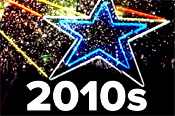 Oscars
for Best Picture typically weren't awarded to Hollywood's biggest blockbusters.
There was a major disconnect between the films with the highest domestic
revenue for the year, and the films honored with Best Picture nominations
and Oscars, especially since 2003. [Note: The
last year that the highest-grossing (domestic) film also won Best Picture
was The Lord of the Rings: The
Return of the King (2003). Since 1980, only three other Best
Picture winners reached No. 1 at the box office: Titanic (1997), Forrest
Gump (1994), and Rain Man (1988).] Oscars
for Best Picture typically weren't awarded to Hollywood's biggest blockbusters.
There was a major disconnect between the films with the highest domestic
revenue for the year, and the films honored with Best Picture nominations
and Oscars, especially since 2003. [Note: The
last year that the highest-grossing (domestic) film also won Best Picture
was The Lord of the Rings: The
Return of the King (2003). Since 1980, only three other Best
Picture winners reached No. 1 at the box office: Titanic (1997), Forrest
Gump (1994), and Rain Man (1988).]
There has been a major difference in taste between what
the Academy honored as the "Best Picture"
and what the moviegoing public voted for as the most popular (by movie-theatre
attendance-viewing). An increase
in movie-ticket prices and shifting moviegoer demographics meant that
the Best Picture winners were now more frequently seen in theatres by niche
adult audiences (baby boomers and seniors). And the Oscar winners were
often lesser-seen, non-mainstream titles. [See also article on Best
Picture Genre Biases.]
Invariably,
the box-office revenue of each Best Picture winner in this decade was
considerably lower than the revenue of the highest-grossing
film of the same year. In some cases, the Oscar win helped to bolster
the already-low revenue figures:
Three of the Best Picture winners in the decade were on
the subject of Hollywood and movie-making: The Artist (2011), Argo
(2012), and Birdman
(2014).
It was widely noted that no film in the top 10 of
films in 2016, in terms of domestic revenue, was based on reality. There
were no biopics, thrillers, dramas, musicals, westerns, or comedies.
All of the top-ranked films were either animated movies or adaptations
about comic-book or sci-fi heroes - and the trend seemed to be strengthening.
Significant Developments in the Decade:
- At its peak in 2004, Blockbuster video rental
stores boasted having 9,000 locations.
 However,
due to intense competition from Netflix, Redbox
automated kiosks, and VOD (video on demand) services, Blockbuster filed
for bankruptcy protection in 2010. In 2011, the company (with 1,700
remaining stores) was purchased by satellite provider Dish Network,
and within about five years, most of the stores were closed. By April
2017, only 10 stores still existed across the entire US, and then by
late summer of 2019, only one Blockbuster store was left - located
in Bend, Oregon. However,
due to intense competition from Netflix, Redbox
automated kiosks, and VOD (video on demand) services, Blockbuster filed
for bankruptcy protection in 2010. In 2011, the company (with 1,700
remaining stores) was purchased by satellite provider Dish Network,
and within about five years, most of the stores were closed. By April
2017, only 10 stores still existed across the entire US, and then by
late summer of 2019, only one Blockbuster store was left - located
in Bend, Oregon.
- The first crowd-funded Oscar winner was the coming-of-age
story, Inocente
(2012), which won the Best Documentary (short feature) Oscar
on February 24, 2013. The film had raised over $52K on Kickstarter
to help fund its making. It was the first Kickstarter-funded movie
to win an Oscar.
- Two of the oldest film studios celebrated their 100th
year anniversaries (both were founded in 1912): Paramount Pictures
(now owned by media conglomerate Viacom, but founded as Famous Players
Studios) and also the last major film studio still headquartered in
Hollywood, and Universal Pictures (founded by Carl Laemmle originally,
and now controlled by General Electric, the parent of NBC), with production
studios in Universal City, CA.
- The 50th Anniversary of the James
Bond Series was celebrated in 2012, with the release of
the 23rd Bond film Skyfall
(2012).
- In 2012, four films crossed the billion-dollar (worldwide)
box-office milestone, surpassing the previous year's record of three
billion-dollar films, and then in 2015, five films crossed the milestone.
The trend of 4-5 films per year topping a billion-dollars worldwide
continued in 2016 (4 films), 2017 (4 films), 2018 (5 films), and 2019
(on track for 6 films, but TBD).
- Also in 2012, high
frame rate technology debuted in the first wide-release, theatrical
feature film using the higher rate for both shooting and projection,
The Hobbit: An Unexpected
Journey (2012) - Peter Jackson's opening film of another trilogy.
The industry standard of 24 fps was doubled to 48 fps.
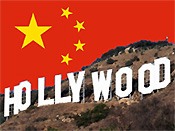 The Chinese film market had become the largest international
film market, even though it was tightly-regulated and subject to quotas. A
major box-office trend by 2012 was that Hollywood films were beginning
to earn more internationally than domestically, with China poised as
the fastest-growing worldwide market. China was becoming a significant
and lucrative film market - in second place behind the US North American
market. Much of the growth in the movie industry
was poised to occur internationally (not domestically), mostly in China
and other burgeoning markets (such as India). To increase revenue shares
even more and make US films more appealing to Chinese audiences, some
film studios were adapting or creating Chinese versions of major films
- with bonus footage. There was a race by the
major film studios to form new partnerships with Chinese companies
and to build production studios in the country for better access to
their fast-growing film market. The Chinese film market had become the largest international
film market, even though it was tightly-regulated and subject to quotas. A
major box-office trend by 2012 was that Hollywood films were beginning
to earn more internationally than domestically, with China poised as
the fastest-growing worldwide market. China was becoming a significant
and lucrative film market - in second place behind the US North American
market. Much of the growth in the movie industry
was poised to occur internationally (not domestically), mostly in China
and other burgeoning markets (such as India). To increase revenue shares
even more and make US films more appealing to Chinese audiences, some
film studios were adapting or creating Chinese versions of major films
- with bonus footage. There was a race by the
major film studios to form new partnerships with Chinese companies
and to build production studios in the country for better access to
their fast-growing film market.- Zombie films continue
to intrigue and spark interest among film-makers (and film-goers). World
War Z (2013) had the highest all-time box-office gross for a zombie
movie, at $202.4 million (domestic), and $540 million (worldwide).
- In 2014, a group of female celebrities
were victimized by hackers who stole their nude 'selfie' photos and
leaked them online. Victimized females included Jennifer Lawrence,
Kate Upton, Jenny McCarthy, Ariana Grande, Mary Elizabeth Winstead,
Emily Ratajkowski, Rihanna, Kirsten Dunst and Kim Kardashian (who later
publically bared all in a photo shoot for Paper magazine).
 In late 2014, the FBI confirmed that North Korea was
behind cyber-attacks on Sony Pictures. Sony was hit by hackers (dubbing
themselves 'Guardians of Peace') on November 24th in response to the
planned release of Columbia Pictures' (owned by Sony) satirical comedy
on Christmas Day, The Interview (2014), about a plot to assassinate
North Korean dictator Kim Jong Un. The Sony Pictures' breach rendered
thousands of its computers inoperable (caused the leak of personal
employee data and some embarrassing emails by company executives),
forced the company to take its computer network offline, disrupted
the company's business operations (i.e., by releasing digital copies
of yet unreleased films), and ultimately forced a cancellation of the
release of The Interview in major US national theatre chains
in the wake of threats from North Korea and its supporters. However,
over 300 independent cinemas showed the film around Christmas Day,
and it was available for rental, with end of year earnings of about
$6.1 million. Sony was expected to lose as much as $100 million on
the film as a result of the state-sponsored attack. Some critics called
the move to censor the film a violation of First Amendment rights and
freedom of creative expression - the right of a movie studio to make
any movie they wished. In late 2014, the FBI confirmed that North Korea was
behind cyber-attacks on Sony Pictures. Sony was hit by hackers (dubbing
themselves 'Guardians of Peace') on November 24th in response to the
planned release of Columbia Pictures' (owned by Sony) satirical comedy
on Christmas Day, The Interview (2014), about a plot to assassinate
North Korean dictator Kim Jong Un. The Sony Pictures' breach rendered
thousands of its computers inoperable (caused the leak of personal
employee data and some embarrassing emails by company executives),
forced the company to take its computer network offline, disrupted
the company's business operations (i.e., by releasing digital copies
of yet unreleased films), and ultimately forced a cancellation of the
release of The Interview in major US national theatre chains
in the wake of threats from North Korea and its supporters. However,
over 300 independent cinemas showed the film around Christmas Day,
and it was available for rental, with end of year earnings of about
$6.1 million. Sony was expected to lose as much as $100 million on
the film as a result of the state-sponsored attack. Some critics called
the move to censor the film a violation of First Amendment rights and
freedom of creative expression - the right of a movie studio to make
any movie they wished.- Tax credits and other financial incentives in other
locations drove more film-making out of California. A non profit group
known as Film-L.A., Inc. released a feature film study (their second
annual report), stating that only 22 of 106 films (about 16%) released
by the major studios in 2014 were actually filmed in California. Local
film production peaked in 1997 when 64% of the top 25 films at the
box-office were filmed in California. California's financial incentives
typically benefited lower-budget films and TV shows. The most prominent
film-making locales used now included New York, Britain, Canada, Georgia,
Louisiana, Australia, and a dozen other states and countries.
- With the release of Godzilla (2014), the Japanese
monster series became the longest, continually-running movie franchise
of all time. Japan's Toho Studios have promoted the Gojira franchise
for nearly 60 years. The original Gojira (Godzilla) film was released
in 1954 by director Ishirô Honda.
 To offset the exorbitant cost of making films, independent
film-makers turned to online crowd-funding, with sites such as Kickstarter
or GoFundMe. The feature-length film Veronica Mars (2014), based
upon the original television series beginning in 2004 (and cancelled
in 2007) raised $5.7 million on Kickstarter, the largest amount ever
raised for a film project at the time (April, 2013) (at 285% of its
goal, with 91,585 total backers). The success of the film catapulted
a string of new movie projects seeking funding from various crowdfunding
platforms. The movie premiered
on March 14, 2014, a year and a day after the appeal launch. To offset the exorbitant cost of making films, independent
film-makers turned to online crowd-funding, with sites such as Kickstarter
or GoFundMe. The feature-length film Veronica Mars (2014), based
upon the original television series beginning in 2004 (and cancelled
in 2007) raised $5.7 million on Kickstarter, the largest amount ever
raised for a film project at the time (April, 2013) (at 285% of its
goal, with 91,585 total backers). The success of the film catapulted
a string of new movie projects seeking funding from various crowdfunding
platforms. The movie premiered
on March 14, 2014, a year and a day after the appeal launch.- The year 2015 marked a significant milestone for a single
studio: Universal released three
films that each grossed over $1 billion (worldwide): Minions (2015), Furious
7 (2015) and Jurassic
World (2015), and in addition, the latter two films both grossed
over $1.5 billion (worldwide).
- Finding Dory (2016) became the highest-grossing
(domestic) animated film of all-time (at $486.3 million domestic),
surpassing Shrek
2 (2004) in the middle of the decade. But then Pixar's sequel
Incredibles 2 (2018) took the top spot, with $608.6 million
(domestic)
-
Disney's The Lion King (2019) surpassed Frozen
(2013) as
the highest-grossing (worldwide) animated film of all-time (at $1.276
billion), with other films trailing behind: Incredibles 2 (2018) at $1.243 billion, and Minions
(2015) at
$1.16 billion.
- Director Quentin Tarantino's western thriller The
Hateful Eight (2015) (distributed by The Weinstein Company) was
reputedly the widest 70mm release the industry has seen in more than
20 years, since Ron Howard's romantic adventure Far and Away (1992).
It was filmed entirely in 70mm (Ultra Panavision 70), a rare widescreen
format usually reserved for big-screen epics.
- The adult computer-animated comedy Sausage Party
(2016) was the first fully American CGI-animated film to be rated
R by the MPAA. The animated film also surpassed South Park: Bigger,
Longer & Uncut
(1999) as the highest-grossing R-rated animated film of all time.
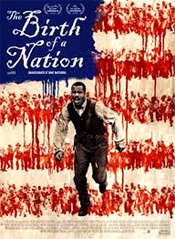 Fox Searchlight's hotly-anticipated slave rebellion
drama The Birth of a Nation (2016) - a biopic about Nat Turner,
stirred political-correctness controversy and negative public opinion
when it was revealed that co-writer/director/star Nate Parker and Birth's co-writer
Jean Celestin had allegedly raped an 18 year-old female, a Penn State
freshman classmate in 1999 during their college years. Parker was charged,
tried and subsequently acquitted. Celestin was convicted of sexual
assault and sentenced to six to 12 months in prison. A judge ordered
a second trial for Celestin following an appeal and the case was overturned
in 2005 after the accuser decided not to testify. Reports later surfaced
that their accuser committed suicide in 2012 at the age of 30, at a
rehab facility. As a result of negative publicity about the trials
and Variety's August 2016 publication of the news of the suicide,
revenues plummeted 60% at the box office in the film's second weekend.
Ultimately, the film managed to earn $15.8 million at the box-office
(domestic) - less than what Searchlight had paid for it at Sundance. Fox Searchlight's hotly-anticipated slave rebellion
drama The Birth of a Nation (2016) - a biopic about Nat Turner,
stirred political-correctness controversy and negative public opinion
when it was revealed that co-writer/director/star Nate Parker and Birth's co-writer
Jean Celestin had allegedly raped an 18 year-old female, a Penn State
freshman classmate in 1999 during their college years. Parker was charged,
tried and subsequently acquitted. Celestin was convicted of sexual
assault and sentenced to six to 12 months in prison. A judge ordered
a second trial for Celestin following an appeal and the case was overturned
in 2005 after the accuser decided not to testify. Reports later surfaced
that their accuser committed suicide in 2012 at the age of 30, at a
rehab facility. As a result of negative publicity about the trials
and Variety's August 2016 publication of the news of the suicide,
revenues plummeted 60% at the box office in the film's second weekend.
Ultimately, the film managed to earn $15.8 million at the box-office
(domestic) - less than what Searchlight had paid for it at Sundance.- There
was an embarrassing and historic mix-up over the Best Picture award,
originally announced for La La Land (2016), which eventually was
rightfully awarded to the African-American coming-of-age drama Moonlight
(2016).
- Google's short animated film Pearl (2016), released
both as a theatrical and 360-degree virtual reality film, became the
first VR film nominated for an Oscar.
- Japan’s consumer electronics company, Funai Electric
Company, announced in mid-2016 that they would permanently curtail
the manufacture of VHS equipment (VCR/DVD player combos), including
videocassettes.
 MTV
became the first major awards show to adopt gender-neutral categories.
During their annual Movie & TV awards ceremony, Emma Watson accepted
MTV’s first 'gender-neutral' acting award - Best Actor for her
role in Beauty and the Beast (2017). MTV
became the first major awards show to adopt gender-neutral categories.
During their annual Movie & TV awards ceremony, Emma Watson accepted
MTV’s first 'gender-neutral' acting award - Best Actor for her
role in Beauty and the Beast (2017).- The action film Wolf Warrior 2 (2017, China) was
the first non-Hollywood film to be listed on the Top 100 box office
(worldwide) hits of all-time, with a worldwide gross of $870 million.
It became the highest-grossing Chinese film ever released, to date.
- 68 year-old Meryl Streep acquired her 21st Academy
Award nomination (a significant record), for her role as Washington
Post publisher-heiress Katharine Graham during the Vietnam War-era
at the time of the Pentagon Papers scandal, in Steven Spielberg's political
thriller The Post (2017).
- A movie subscription service known as MoviePass (founded
in 2011) offered customers to purchase three movie tickets per month
for a monthly fee; the service became well-known when it offered -
in August 2017 - a short-lived plan with an unlimited, single
film per day priced at $9.95 per month; in just six months, the service
had 2 million subscribers by February 2018. The company's tremendous
growth was soon unsustainable by the end of the 2018 summer movie season,
and the subscription offer was downgraded and transitioned to a monthly
limited plan with other availability restrictions. The subscriber base
to MoviePass dropped precipitously following
the service’s complete rehaul of its plans and pricing. However,
MoviePass proved that movie-goers loved an affordable film subscription
plan. Competitors to MoviePass included the creation of AMC's Stubs
A-List, Regal Unlimited, Sinemia, and Cinemark's Movie Club..
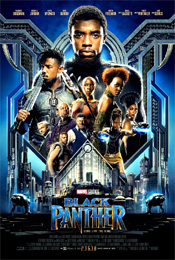 Black Panther (2018) - one of the films in the Marvel
Cinematic Universe (a series of superhero films), became
the first superhero
movie to be nominated for Best Picture. The domestic box-office total
for the superhero film, $700.5 million, was virtually the same as the
domestic total made by all nine of the Best Picture nominees in the
years 2016 and 2017! It scored three Oscar wins for Best Costume Design,
Best Production Design and Best Original Score. It was Marvel's first black
superhero standalone film; it was an historic achievement that a film
in Marvel's Cinematic Universe had
now won its first three Oscars - and two were also exceptional. The
winner in the category of Best Production Design, Hannah Beachler,
became the first African-American to win in the category. And the winner
for Best Costume Design, Ruth Carter, was also the first black person
to win the Oscar in her category. Black Panther (2018) - one of the films in the Marvel
Cinematic Universe (a series of superhero films), became
the first superhero
movie to be nominated for Best Picture. The domestic box-office total
for the superhero film, $700.5 million, was virtually the same as the
domestic total made by all nine of the Best Picture nominees in the
years 2016 and 2017! It scored three Oscar wins for Best Costume Design,
Best Production Design and Best Original Score. It was Marvel's first black
superhero standalone film; it was an historic achievement that a film
in Marvel's Cinematic Universe had
now won its first three Oscars - and two were also exceptional. The
winner in the category of Best Production Design, Hannah Beachler,
became the first African-American to win in the category. And the winner
for Best Costume Design, Ruth Carter, was also the first black person
to win the Oscar in her category.- In 2018, the Marvel
Cinematic Universe became
the first film franchise to gross more than $16 billion (worldwide
revenue) with the release of Avengers: Infinity War (2018). And
then after the releases of three other blockbusters in 2019 (and reaching
a total of 23 films in the franchise), Captain
Marvel (2019), Avengers:
Endgame (2019), and Spider-Man: Far From Home (2019), the
franchise topped all other franchises with a total of over $22.5 billion
(worldwide) - and was still growing.
- In late 2018 after two years of providing a unique streaming
service (a joint venture of Turner Classic Movies
and the Criterion Collection), WarnerMedia's Filmstruck ended.
The niche service was one of the few ways to watch examples of classic
Hollywood films, arthouse cult movies, foreign pictures, and repertory
cinema. To fill the void, The Criterion Collection launched its own
standalone streaming service in spring 2019.
- There were an astounding number of franchise films in
2019: 58 in total, that took up 82% of the worldwide Hollywood
box office. In the same year, Disney Studios accounted for more than
35% of domestic market share for the year.
- Disney's and Marvel's Avengers: Endgame (2019) took
over the top spot from Avatar (2009), becoming the top-grossing
film of all time (worldwide) with $2.79 billion.
- South Korean writer/director Bong Joon Ho's subtitled
psychological thriller, twisting drama and dark comedy Parasite (2019,
S. Korea) was a surprise, upset Best Picture winner. It marked
the first Best Picture nomination for a South Korean film (and win)
in the Academy's history. It was the first non-English language film
to ever win the top honor. It was only the 10th foreign-language film
to be nominated for Best Picture. It was the first nomination and
win in the category of Best International Feature Film for a
South Korean film. It also won the Palme d’Or at Cannes (the
first Korean film to do so). To date, it was one of only 12
films that won Best Picture without receiving a single
acting nomination.
 Film History of the 2010s
Film History of the 2010s
Part 1, Part
2, Part 3, Part
4, Part 5

 
|

